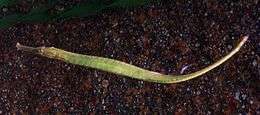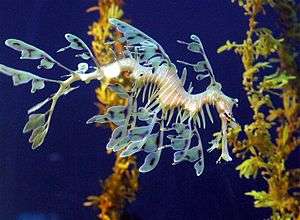Syngnathidae
| Syngnathidae | |
|---|---|
 | |
| Alligator pipefish, Syngnathoides biaculeatus | |
| Scientific classification | |
| Kingdom: | Animalia |
| Phylum: | Chordata |
| Class: | Actinopterygii |
| Order: | Syngnathiformes |
| Family: | Syngnathidae Rafinesque, 1810 |
| Subfamilies and genera | |
|
See text | |
The Syngnathidae are a family of fish which includes the seahorses, the pipefishes, the pipehorses, and the leafy, ruby, and weedy seadragons. The name is derived from Greek, syn, meaning "fused" or "together", and gnathus, meaning "jaws". This fused jaw trait is something the entire family has in common.[1]
Description and biology
Syngnathids are found in temperate and tropical seas across the world. Most species inhabit shallow, coastal waters, but a few are known from the open ocean, especially in association with sargassum mats. They are characterised by their elongated snouts, fused jaws, the absence of pelvic fins, and by thick plates of bony armour covering their bodies. The armour gives them a rigid body, so they swim by rapidly fanning their fins. As a result, they are relatively slow compared with other fishes, but are able to control their movements with great precision, including hovering in place for extended periods.[2]
Uniquely, after syngnathid females lay their eggs, the male then fertilizes and carries the eggs during incubation, using one of several methods. Male seahorses have a specialized ventral pouch to carry the eggs, male sea dragons attach the eggs to their tails, and male pipefish may do either, depending on their species.[3] The most fundamental difference between the different lineages of the Syngnathidae family is the location of male brood pouch.[4] The two locations are on the tail (Urophori) and on the abdomen (Gastrophori).[5] There is also variation in Syngnathid pouch complexity with brood pouches ranging from simple ventral gluing areas to fully enclosed pouches.[6] In species with more developed, enclosed pouches it has been demonstrated that males directly provide their brood with not only nutrients[7] but also immunity to pathogens.[8] Syngnathids with more developed brood pouches are also known to be able to partially or completely abort a brood from a female with low fitness.[9]
A wide variety of mate choice and mating competition has been observed in Syngnathidae.[10] For example, Hippocampus fuscus exhibits conventional sex roles of males competing for female access[11] while Corythoichthys haematopterus is completely sex role reversed.[12] Most conventional sex role syngnathids are monogamous whereas sex role reversed species mostly exhibit polygamous behavior.[5]
Seahorses and pipefish also have a unique feeding mechanism, known as elastic recoil feeding. Although the mechanism is not well-understood, seahorses and pipefish appear to have the ability to store energy from contraction of their epaxial muscles (used in upward head rotation), which they then release, resulting in extremely fast head rotation to accelerate their mouths towards unsuspecting prey.[13][14]
Classification
- Subfamily Hippocampinae
- Genus Hippocampus (seahorses)
- Subfamily Syngnathinae (pipefishes)
- Genus Acentronura
- Genus Amphelikturus
- Genus Anarchopterus
- Genus Apterygocampus
- Genus Bhanotia
- Genus Bryx
- Genus Bulbonaricus
- Genus Campichthys
- Genus Choeroichthys
- Genus Corythoichthys
- Genus Cosmocampus
- Genus Doryichthys
- Genus Doryrhamphus
- Genus Dunckerocampus
- Genus Enneacampus
- Genus Entelurus
- Genus Festucalex
- Genus Filicampus
- Genus Halicampus
- Genus Haliichthys
- Genus Heraldia
- Genus Hippichthys
- Genus Histiogamphelus
- Genus Hypselognathus
- Genus Ichthyocampus
- Genus Idiotropiscis
- Genus Kaupus
- Genus Kimblaeus
- Genus Kyonemichthys
- Genus Leptoichthys
- Genus Leptonotus
- Genus Lissocampus
- Genus Maroubra
- Genus Micrognathus
- Genus Microphis
- Genus Minyichthys
- Genus Mitotichthys
- Genus Nannocampus
- Genus Nerophis
- Genus Notiocampus
- Genus Penetopteryx
- Genus Phoxocampus
- Genus Phycodurus
- Genus Phyllopteryx
- Genus Pseudophallus
- Genus Pugnaso
- Genus Siokunichthys
- Genus Solegnathus
- Genus Stigmatopora
- Genus Stipecampus
- Genus Syngnathoides
- Genus Syngnathus
- Genus Trachyrhamphus
- Genus Urocampus
- Genus Vanacampus
Images of species
| Wikimedia Commons has media related to Syngnathidae. |
References
- ↑ Sara A. Lourie, Amanda C.J. Vincent and Heather J. Hall: Seahorses: An Identification Guide to the World's Species and their Conversation. London: Project Seahorse, 1999
- ↑ Orr, J.W & Pietsch, T.W. (1998). Paxton, J.R. & Eschmeyer, W.N., eds. Encyclopedia of Fishes. San Diego: Academic Press. pp. 168–169. ISBN 0-12-547665-5.
- ↑ "Seahorses and their relatives". NSW Department of Primary Industries - Fisheries. Archived from the original on 2008-05-01. Retrieved 2008-06-13.
- ↑ Hamilton, H., N. Saarman, G. Short, A. B. Sellas, B. Moore, T. Hoang, C. L. Grace, M. Gomon, et al. 2016. Molecular phylogeny and patterns of diversification in syngnathid fishes. Molecular Phylogenetics and Evolution. In press. http://dx.doi.org/10.1016/j.ympev.2016.10.003.
- 1 2 Wilson, A. B., I. Ahnesjö, A. C. J. Vincent, and A. Meyer. 2003. The dynamics of male brooding, mating patterns, and sex roles in pipefishes and seahorses (Family Syngnathidae). Evolution 57:1374–1386.
- ↑ Dawson, C. E. 1985. Indo-Pacific pipefishes (Red Sea to the Americas). Gulf Coast Research Laboratory, Ocean Springs, MS. [as cited by Wilson et al. (2003)]
- ↑ Ripley, J. L., and C. M. Foran. 2008. Direct evidence for embryonic uptake of paternally-derived nutrients in two pipefishes (Syngnathidae: Syngnathus spp.). Journal of Comparative Physiology B 179:325–333.
- ↑ Roth, O., V. Klein, A. Beemelmanns, J. P. Scharsack, and T. B. H. Reusch. 2012. Male pregnancy and biparental immune priming. The American Naturalist 180:802–814.
- ↑ Paczolt, K. A., and A. G. Jones. 2010. Post-copulatory sexual selection and sexual conflict in the evolution of male pregnancy. Nature 464:401–404.
- ↑ Rosenqvist, G., and A. Berglund. 2011. Sexual signals and mating patterns in Syngnathidae. Journal of Fish Biology 78:1647-1661.
- ↑ Vincent, A. C. J. 1994. Seahorses exhibit conventional sex roles in mating competition, despite male pregnancy. Behaviour 128:135–151.
- ↑ Sogabe, A., and Y. Yanagisawa. 2007. Sex-role reversal of a monogamous pipefish without higher potential reproductive rate in females. Proceedings of the Royal Society B: Biological Sciences 274:2959–2963.
- ↑ Van Wassenbergh et al., J. R. Soc. Interface 5:285(2008)
- ↑ Van Wassenbergh et al., Biol. Lett. 5:200 (2009)
External links
| Wikispecies has information related to: Syngnathidae |
- Syngnathidae at the Encyclopedia of Life

- Froese, Rainer, and Daniel Pauly, eds. (2006). "Syngnathidae" in FishBase. January 2006 version.
- Seahorses and their Relatives
- Smith, J.L.B. 1963.Fishes of the family Syngnathidae from the Red Sea and the Western Indian Ocean. Ichthyological Bulletin; No. 27. Grahamstown: Department of Ichthyology, Rhodes University.



